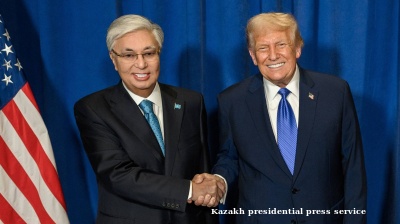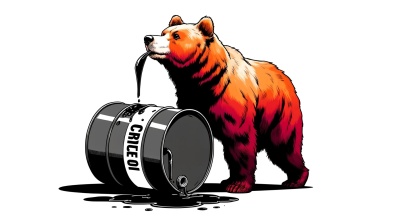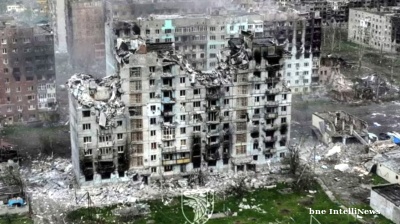There are high hopes for 2017, when most of the countries in Eastern Europe should finally return to growth following several years of grinding recession and a low-key but very painful crisis.
Russia and Ukraine are both in focus, as both are expected to begin their recoveries, but the view of the two foes is very different: January brought the same breathless articles about Ukraine’s bright future as it has done every year. Last year the government pushed through an International Monetary Fund-compliant budget, leading to predictions of a rapid deployment of the next $1bn tranche of aid money. That didn't happen, as Kyiv has dragged its heels on anti-corruption reforms, so this year the breathless reporting was not puffing quite as heavily. However, many of Ukraine’s main macroeconomic indicators are back in the black and the economy will start to climb out of the deep, dark hole it has fallen into.
The outlook for Russia is routinely downplayed and predictions of its imminent collapse/revolution/attack continue to make the rounds for the umpteenth year. But stepping back and stripping away the political tint, both these stories are now routinely coloured with how well their economies are actually faring?
The brief answer is in relative terms Ukraine is bouncing off the hard floor of its 2015 meltdown well, but in absolute terms Russia remains at least a decade in front. While Russia is doing less well on the relative indicators, its economy is a lot more resilient than that of its little brother. Ukraine is still at the start of the process, so any reform it makes will be beneficial. Russia is a lot more developed and so will not grow much unless it makes a lot of really hard-to-do reforms – and so far it is failing to make them. However, pundits are probably overly optimistic about Ukraine and overly pessimistic about Russia.
The charts below draw on the bne IntelliNews database that covers our 30 countries and our monthly country reports that are available to subscribers (samples here). The charts are interactive and draw on our database so will update automatically each month.
Growth at last
Ukraine’s GDP growth had already returned by the third quarter of 2016, expanding by about 2%, while Russia’s contracted by 0.4% over the same period.
The growth comes as a welcome relief for the Kyiv government after the economy basically collapsed in 2015; of course, the third-quarter growth is partly a result of measuring against this low base. Ukraine’s 17% contraction in the first quarter of 2015 was truly cataclysmic. Even Russia’s economy only contracted by 7% in the aftermath of the 2008 crisis, which was considered extreme at the time, as the economy had been expanding by 6-8% for the eight years prior to the meltdown.
However, Ukraine’s growth is not all ‘dead-cat bounce’, but also a result of the stabilisation of the economy and the beneficial effects of a deep devaluation, which saw the value of the hryvnia plummet from around UAH8 to the dollar to UAH24 now. Growth was also helped along by the dramatic fall in oil and gas prices, the import of which has been a heavy drain on the treasury, as well as a rally in steel prices, one of the country’s biggest exports. Bumper harvests helped both Ukraine and Russia, which are both major grain producers. And there were major reforms to the bank sector and energy market, which contributed to improved business confidence.
But Ukraine is going to have to grow a lot faster for at least a decade to even start catching up with Russia or any of its would-be EU peers. “Ukraine is a big country with a small economy,” is how one Kyiv-based investor describes the problem. Having ignored even the most basic reforms for two decades, Ukraine is one of only two former Soviet republics that has yet to surpass the Soviet 1989 levels of income. Having said that, Ukraine’s very backwardness is also its greatest appeal: it has all the catch-up growth ahead of it and that will earn investors brave enough to get in on the ground floor triple-digit annual returns. Ukraine is the last great post-Soviet investment story.
By contrast Russia has made a lot of reforms, and parts of the economy – like retail, telecommunications and transport – are already modern and competitive, so its income (in PPP adjusted terms) is on a par with the lower end of the EU. Russia’s life has been made easier by its massive natural resources to bolster its economy, which is more than ten-times the size of Ukraine’s, despite only having three-times more people.
The size of Ukraine’s economy was stagnant for much of its first decade of independence, averaging $87.19bn from 1987 until 2015, but grew in the noughties to reach an all-time high of $181.33bn in 2013 before slumping back. The economy has since recovered much of the lost ground and finished 2016 at about $84bn.
The growth of Russia’s economy has been much more dramatic, thanks to its relatively diversified nature. (Oil and gas only make up about 15% of GDP, while retail and services account for more than half.) The 1990s under Boris Yeltsin were a nightmare for the average Russian, but the country boomed in the noughties partly thanks to the slow run-up of oil prices from $10 to a peak of $150. Nominal GDP in Russia averaged $876.86bn between 1989 until 2015 – almost exactly ten-times the size of Ukraine’s – rising from a record low of $195.91bn set in 1999 to reach an all-time high of $2,230.63bn in 2013.
The size of the Russian economy in dollar terms has halved since then and ended 2016 at $1,325bn, but this contraction is still no way near the six-fold collapse in Ukraine. For most Russians some belt-tightening is sufficient to get through these lean years, while in Ukraine livelihoods have been destroyed. This contrast is clearest in the relative levels of unemployment: Russia’s economy is enjoying full employment, while the jobless rate in Ukraine is around 9%.
Looking at GDP per capita and the story is similar. Ukraine’s per-capita GDP started the millennium at $636 per person and tripled to end 2016 at $1,885. However, in per-capita terms Ukraine is only now where Russia was in 2000 with a per-capita GDP of $1,770, which has quintupled over the last decade and half to end 2016 at $9,239.
Both countries have been through the mangle in the last five years, with Ukraine’s per-capita GDP halving from a peak of $3,854 set in 2012 and Russia’s falling slightly from a peak of $15,409 also set in 2012. The difference is that even at its peak Ukraine was one of the poorest countries in Europe, while Russia had already overtaken Portugal in absolute per-capita terms and was hot on the heels of Spain before the 2008 crisis pulled the rug from under its feet.
A lot of Russia’s advantages over Ukraine is due to the simple fact it has a lot more money. Initially this was due to the export of raw materials, but Russia has drawn further ahead as businessmen in the non-political parts of the economy have been investing and building their businesses for more than decade; many have reached critical mass. Ukraine is still at the stage where it relies heavily for growth on what raw materials it has.
Ukraine’s gross international reserves (GIR) have more than halved since president Viktor Yanukovych was ousted in 2014 and ended 2016 at $15.5bn, or 3.6 months of import cover, which is around what economists consider the minimum necessary to ensure the stability of the currency. Russia has ten times that amount and finished 2016 with just shy of $400bn in reserves. That is the equivalent of 24 months of import cover and also covers 75% of Russia’s entire external debt. In comparative terms Russia has $2,723 of reserves per person against Ukraine’s $355.
Russia’s reserves provide a formidable strategic backstop that has allowed the government to withstand international sanctions and absorb most of the pain of devaluation, while at the same time re-equipping its army as part of Putin’s geopolitical showdown with the West.
Ukraine has enough in reserve to function – but only just. It has a massive investment bill to pay if it is going to transform its economy and remains extremely vulnerable to external shocks. As a result, it is reliant on the drip-feed of aid money from the international community.
Other indicators
Looking through the other leading macroeconomic indicators and the same story of cataclysm to relative recovery is writ large in Ukraine’s statistics.
Inflation soared during Ukraine’s meltdown to over 60% at the start of 2015, but has fallen off dramatically from the start of 2016 and finished the year at around 12.1% – still high but manageable. Russia on the other hand had a sterling year as the Central Bank of Russia (CBR) managed to drive inflation down to under 6% for the first time since the fall of the Soviet Union. This is only the second time that Russian inflation has fallen into single digits in the last 25 years, the other time being at the start of 2008. The Kremlin’s economic reformists are hoping that if the CBR can hit its goal of 4% inflation – a developed world inflation rate – then that could trigger a credit-led investment boom.
The picture with industrial production is the same: both countries have suffered from industrial activity being crushed by recession, but both saw output recover at the end of 2016 as momentum builds in the economy. The difference again is only in scale – the value of Russia’s industrial production dwarfs Ukraine’s, which remains stunted and anaemic by comparison.
Retail in Ukraine shows the same pattern of complete collapse in 2015 followed by a rapid turn-about at the start of 2016. Russian retail suffered at the end of 2015, when retail sales contracted by more than 15% in December of that year. In Ukraine it was of course worse, with retail sales falling over 30% ten months earlier. However, while Ukrainians were back in the shops in 2016, Russian punters remain under pressure. Soaring food prices meant the spending share on staples rose from about a third to over half in the last year, and now makes up 70-80% of household spending according to some estimates. The greater impact of the crisis on the Russian consumer is the classic case of the taller you are the harder you fall, as almost all prices for all goods have long ago converged with European averages, whereas the cost of living in Kyiv is still low.
The difference between the two is easily seen in the relative differences in income, with Russian incomes fluctuating between $400 a month and $600 over the last two years, whereas Ukrainian incomes have been relative stagnant at about $200 a month for several years. In this President Petro Poroshenko shares the same problem as President Vladimir Putin: while the economy is now on the mend, the benefits are not yet being felt by the people, who are being squeezed by rising food and utilities costs, while real wage increases are barely keeping pace with inflation.
This will eventually turn into political tension, but in Russia’s case the decade-long boom prior to the onset of recession allowed most Russians to build up a comfortable savings cushion that will allow them to bear a lot more pain for longer than their Ukrainian counterparts. Moreover, thanks to falling inflation, consumers in Russia are likely to see real incomes rise this year, whereas the persistently high inflation in Ukraine will continue to squeeze its consumers.
ED NOTE: Much of the material in this article was drawn from the bne IntelliNews Eastern Europe OUTLOOK 2017, part of our series of country reports that are available to subscribers. Take a look at our sample monthly Russia Report and Ukraine Report. Contact sales@intellinews.com for more information.
Features
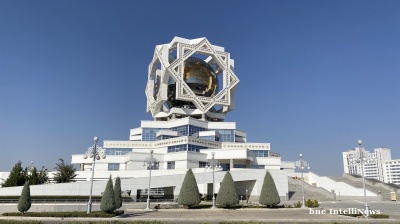
Washington has a new focus on a Caspian energy play
For most of the last three decades since winning independence, Central Asia has been a bit of a backwater. Not any more. The Trump administration is becoming more focused on Turkmenistan's vast gas reserves and can smell money and power there.

BOTAŞ and Turkey’s hub ambition: from “30-year dream” to cross-border reality
For Ankara, the symbolism is as important as the molecules: Turkey’s energy map is shifting from end-market to hub.
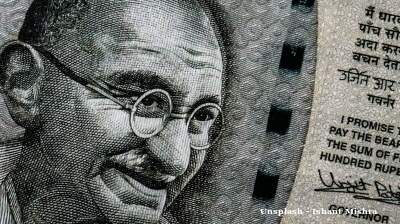
Indian bank deposits to grow steadily in FY26 amid liquidity boost
Deposit growth at Indian banks is projected to remain adequate in FY2025-26, supported by an improved liquidity environment and regulatory measures that are expected to sustain credit expansion of 11–12%
